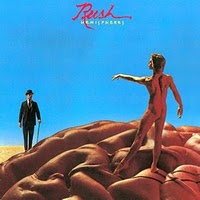 Hemispheres is the culmination of all that Rush had been striving for since Neil Peart ascended to the drum stool back on Fly By Night. The side-long title track is a winding conceptual piece that one-ups 2112 in it’s uniformity and metaphorical marriage of paperback fantasy with egghead philosophy. A continuation of A Farewell To Kings’ “Cygnus X-1” (on tour Rush would play both pieces together, forming one 30-minute monstrosity), “Hemispheres” tells a convoluted tale of the “battle of heart and mind” that dabbles in Greek mythology and Nietzsche-inspired psychology, set to an ever-unfolding barrage of head-spinning riffs. But it’s side two of Hemispheres that ensures it’s classic status, with the brief, but hard-hitting and lyrically direct “Circumstances,” ably leading things off. “The Trees,” an almost Brothers Grimm styled allegorical tale of the pitfalls of collectivism, quickly became a Rush standard, as did the multi-part instrumental “La Villa Strangiato.” Subtitled with a wink, “An Exercise in Self-Indulgence,” the showcase is a tour-de-force of prog-rock muscle that probably inspired half of the kids who heard it to hone their musical chops, while the other half headed straight for the record store’s newly-added punk bin. But in it’s own way, Hemispheres is as uncompromising a statement as any, and with it Rush carved a permanent niche as leaders of their own pencil-necked revolution. –Ben
Hemispheres is the culmination of all that Rush had been striving for since Neil Peart ascended to the drum stool back on Fly By Night. The side-long title track is a winding conceptual piece that one-ups 2112 in it’s uniformity and metaphorical marriage of paperback fantasy with egghead philosophy. A continuation of A Farewell To Kings’ “Cygnus X-1” (on tour Rush would play both pieces together, forming one 30-minute monstrosity), “Hemispheres” tells a convoluted tale of the “battle of heart and mind” that dabbles in Greek mythology and Nietzsche-inspired psychology, set to an ever-unfolding barrage of head-spinning riffs. But it’s side two of Hemispheres that ensures it’s classic status, with the brief, but hard-hitting and lyrically direct “Circumstances,” ably leading things off. “The Trees,” an almost Brothers Grimm styled allegorical tale of the pitfalls of collectivism, quickly became a Rush standard, as did the multi-part instrumental “La Villa Strangiato.” Subtitled with a wink, “An Exercise in Self-Indulgence,” the showcase is a tour-de-force of prog-rock muscle that probably inspired half of the kids who heard it to hone their musical chops, while the other half headed straight for the record store’s newly-added punk bin. But in it’s own way, Hemispheres is as uncompromising a statement as any, and with it Rush carved a permanent niche as leaders of their own pencil-necked revolution. –Ben
Rock
T. Rex “Zinc Alloy and the Hidden Riders of Tomorrow” (1974)
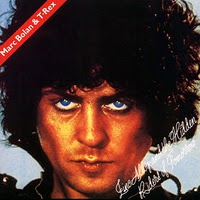 Conventional wisdom holds that Marc Bolan & T. Rex started to sink with Zinc Alloy and the Hidden Riders of Tomorrow (or was it Tanx?) into his bloated period of mid-seventies mediocrity, but as a Bolan apologist I still hold it in high regard. Certainly, Zinc Alloy is the strangest release yet from the glitter-rock fairy, an often uncomfortable and chaotic collection that radiates a nasty, coke-fueled jitter. Bolan’s idea of the new T-Rex sound was some sort of bubblegum-soul hybrid, and to that end he introduced future Mrs. Bolan, Gloria Jones, to the T-Rex fold, whose blood-curdling wail ironically possessed about as much soul as a set of fingernails being drawn across a chalkboard. Her voice, plus heavy doses of Bolan’s spazzy fuzz guitar, and strings and synthesizers, are some of the odd limbs comprising this stumbling, glam-funk Frankenstein. But Bolan could pull killer hooks out of his wizard’s hat no matter how deluded his vision had become in his quest to break the American market, witness the jumpy “Venus Loon,” jubilant “Interstellar Soul” and “Nameless Wilderness” or glam grind of “Liquid Gang.” Elsewhere, song fragments like “Galaxy” and “Spanish Midnight” house equally effective melodies, while the sweaty “Explosive Mouth” and grand “Carlisle Smith & the Old One” are other lost gems from this release. The relatively tame “Teenage Dream,” with it’s retro-50’s lean, would make for an odd single flop from the album. –Ben
Conventional wisdom holds that Marc Bolan & T. Rex started to sink with Zinc Alloy and the Hidden Riders of Tomorrow (or was it Tanx?) into his bloated period of mid-seventies mediocrity, but as a Bolan apologist I still hold it in high regard. Certainly, Zinc Alloy is the strangest release yet from the glitter-rock fairy, an often uncomfortable and chaotic collection that radiates a nasty, coke-fueled jitter. Bolan’s idea of the new T-Rex sound was some sort of bubblegum-soul hybrid, and to that end he introduced future Mrs. Bolan, Gloria Jones, to the T-Rex fold, whose blood-curdling wail ironically possessed about as much soul as a set of fingernails being drawn across a chalkboard. Her voice, plus heavy doses of Bolan’s spazzy fuzz guitar, and strings and synthesizers, are some of the odd limbs comprising this stumbling, glam-funk Frankenstein. But Bolan could pull killer hooks out of his wizard’s hat no matter how deluded his vision had become in his quest to break the American market, witness the jumpy “Venus Loon,” jubilant “Interstellar Soul” and “Nameless Wilderness” or glam grind of “Liquid Gang.” Elsewhere, song fragments like “Galaxy” and “Spanish Midnight” house equally effective melodies, while the sweaty “Explosive Mouth” and grand “Carlisle Smith & the Old One” are other lost gems from this release. The relatively tame “Teenage Dream,” with it’s retro-50’s lean, would make for an odd single flop from the album. –Ben
Captain Beefheart “Shiny Beast (Bat Chain Puller)” (1978)
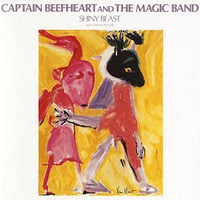 Captain Beefheart has always been sort of an enigma for me, an artist who I greatly respect and enjoy, but never quite fully understand where he is coming from. I finally got to the point where I put aside all my questioning and decided to just take in all the wacky bizarre features he incorporates. This notion proved to be the best way to listen to the Captain. Let’s face it – he’s weird, but he experiment’s with so many different things that you have to give him credit for being one of the most daring artists out there. I’ve come to be a big fan of all his music, but I still don’t know how to describe it. It’s similar to Frank Zappa, well, maybe not because I really can’t stand Frank’s music. I guess you could say it’s a cross between a free jazz freak out and an art-rock experiment. Whatever it is, it’s very interesting. And Shiny Beast is by far the most exciting album I have found of his. Every song is completely different from the next and it’s one of those rare albums where it never seems to get dull. If you are even remotely curious about the music of Captain Beefheart I would say begin here or with Trout Mask Replica; both are exceptional releases guaranteed to not disappoint. –Jason
Captain Beefheart has always been sort of an enigma for me, an artist who I greatly respect and enjoy, but never quite fully understand where he is coming from. I finally got to the point where I put aside all my questioning and decided to just take in all the wacky bizarre features he incorporates. This notion proved to be the best way to listen to the Captain. Let’s face it – he’s weird, but he experiment’s with so many different things that you have to give him credit for being one of the most daring artists out there. I’ve come to be a big fan of all his music, but I still don’t know how to describe it. It’s similar to Frank Zappa, well, maybe not because I really can’t stand Frank’s music. I guess you could say it’s a cross between a free jazz freak out and an art-rock experiment. Whatever it is, it’s very interesting. And Shiny Beast is by far the most exciting album I have found of his. Every song is completely different from the next and it’s one of those rare albums where it never seems to get dull. If you are even remotely curious about the music of Captain Beefheart I would say begin here or with Trout Mask Replica; both are exceptional releases guaranteed to not disappoint. –Jason
Soundtrack “Performance” (1970)
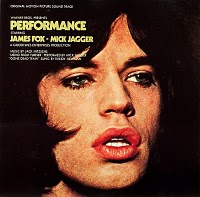 Even if you haven’t seen the film — and heck, if you haven’t, why not? — this is a remarkably satisfying soundtrack album, put together by Jack Nitzsche and featuring Ry Cooder on guitar. (In places this sounds extremely close to Cooder’s own scores, such as for Paris, Texas.) Randy Newman sings “Gone Dead Train” in a much more urgent style than anything on his own early albums, while Mick Jagger’s version of “Memo from Turner” — with Cooder on guitar and members of Traffic — is a gloriously sleazy blues that should be in any Stones fan’s collection. (If you’ve only heard the Stones’ own fumbled version on Metamorphosis — according to legend, deliberately sabotaged by Keith as revenge for Mick screwing Anita Pallenberg on set — you really haven’t heard the song at all.) And how can you pass up a soundtrack that has the good sense to include the Last Poets’ “Wake Up Niggers”? (The first “rap” I’d ever heard.) –Brad
Even if you haven’t seen the film — and heck, if you haven’t, why not? — this is a remarkably satisfying soundtrack album, put together by Jack Nitzsche and featuring Ry Cooder on guitar. (In places this sounds extremely close to Cooder’s own scores, such as for Paris, Texas.) Randy Newman sings “Gone Dead Train” in a much more urgent style than anything on his own early albums, while Mick Jagger’s version of “Memo from Turner” — with Cooder on guitar and members of Traffic — is a gloriously sleazy blues that should be in any Stones fan’s collection. (If you’ve only heard the Stones’ own fumbled version on Metamorphosis — according to legend, deliberately sabotaged by Keith as revenge for Mick screwing Anita Pallenberg on set — you really haven’t heard the song at all.) And how can you pass up a soundtrack that has the good sense to include the Last Poets’ “Wake Up Niggers”? (The first “rap” I’d ever heard.) –Brad
Humble Pie “Rock On” (1971)
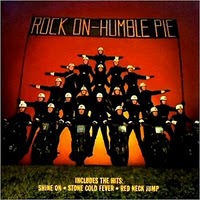 “Rock On” is Classic Rock with a Capitol C! It’s also The Pie’s very best record (in my Humble opinion). On this album a soulful Steve Marriott (of Small Faces) and guitar God Peter Frampton seamlessly blend all that was good about the seventies into one big sweaty orgy: hard rock, blues, country, gospel and R&B, all rolled up in glitter. Fans of Exile-era Stones, The Faces and Led Zeppelin will find something to love here. Throw this one on and watch the smiles on people’s faces as they groove to “Shine On,” “Sour Grain” and “Stone Cold Fever,” just three of many great tracks here. Criminally forgotten; shine some light back on “Rock On!” –David
“Rock On” is Classic Rock with a Capitol C! It’s also The Pie’s very best record (in my Humble opinion). On this album a soulful Steve Marriott (of Small Faces) and guitar God Peter Frampton seamlessly blend all that was good about the seventies into one big sweaty orgy: hard rock, blues, country, gospel and R&B, all rolled up in glitter. Fans of Exile-era Stones, The Faces and Led Zeppelin will find something to love here. Throw this one on and watch the smiles on people’s faces as they groove to “Shine On,” “Sour Grain” and “Stone Cold Fever,” just three of many great tracks here. Criminally forgotten; shine some light back on “Rock On!” –David
Jethro Tull “Songs From the Wood” (1977)
 I love it! It’s a glorious celebration of folk traditions and lore. These are presented for our consumption on a richly musical platter. It opens shakily with the title track which starts off vocal-only. That part doesn’t work for me, but as soon as the music kicks in, I’m grabbed. As a song it certainly sets the scene and the tone for the album. “Jack-in-the-Green” is a vaguely amusing song about nature’s relationship with the seasons and the changing planet. “Cup of Wonder” seems to be an upbeat celebration of May Day (and of life?), while “Hunting Girl” is a weird tale of social and sexual impropriety. It seems a little out of place. “Ring Out, Solstice Bells” is a joyous celebration of the winter solstice. It should not be confused with what are generally known as Christmas songs. This is a purely pagan affair. “Velvet Green” brings together nature, sex and love themes very successfully. Very interesting; very earthy; very folky. “The Whistler” is OK. It just reminds me (musically) of something that Cat Stevens did before. “Pibroch (Cap in Hand)” is the longest, darkest and heaviest track on the album. It’s pretty good, featuring some folky instrumental passages, but these don’t all work as well as each other. “Fire at Midnight” is a touching little love song that closes the album. I really like the theme of the album. I think it works very well and the songs have been put together well. There is some great music too. It sounds very rich: acoustic and electric guitars, flute, various kinds of percussion, bass, piano and assorted other instruments. It’s an excellent production. With this album Jethro Tull ignored the dawn of punk and went back to their roots. –Jim
I love it! It’s a glorious celebration of folk traditions and lore. These are presented for our consumption on a richly musical platter. It opens shakily with the title track which starts off vocal-only. That part doesn’t work for me, but as soon as the music kicks in, I’m grabbed. As a song it certainly sets the scene and the tone for the album. “Jack-in-the-Green” is a vaguely amusing song about nature’s relationship with the seasons and the changing planet. “Cup of Wonder” seems to be an upbeat celebration of May Day (and of life?), while “Hunting Girl” is a weird tale of social and sexual impropriety. It seems a little out of place. “Ring Out, Solstice Bells” is a joyous celebration of the winter solstice. It should not be confused with what are generally known as Christmas songs. This is a purely pagan affair. “Velvet Green” brings together nature, sex and love themes very successfully. Very interesting; very earthy; very folky. “The Whistler” is OK. It just reminds me (musically) of something that Cat Stevens did before. “Pibroch (Cap in Hand)” is the longest, darkest and heaviest track on the album. It’s pretty good, featuring some folky instrumental passages, but these don’t all work as well as each other. “Fire at Midnight” is a touching little love song that closes the album. I really like the theme of the album. I think it works very well and the songs have been put together well. There is some great music too. It sounds very rich: acoustic and electric guitars, flute, various kinds of percussion, bass, piano and assorted other instruments. It’s an excellent production. With this album Jethro Tull ignored the dawn of punk and went back to their roots. –Jim
Kate Bush “Hounds of Love” (1985)
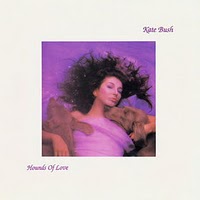 Albums that take you into another world never seem to have the adorable pop structures our ears need to play them as much as we’d like to. Kate Bush solved this by breaking the album into two sides, suiting both. Before you know it, it’s one and the same. There isn’t a more comforting voice in the world than Kate Bush’s, as far as I’m concerned. From the vivid opening trio to the down right moving “Hello Earth”, it’s amazing to contemplate Bush did this all on her own in her studio. The word genius gets flung around so often in music culture, but listening to Hounds of Love front to back there isn’t another word that seems more appropriate. It’s not about single-handedly inspiring every female musician to come or making some great songs, it’s about making one of the most strangest, complete, moving albums ever made that takes you into a different world every time and yet has you humming when you return back to your home in the city. –Allistair
Albums that take you into another world never seem to have the adorable pop structures our ears need to play them as much as we’d like to. Kate Bush solved this by breaking the album into two sides, suiting both. Before you know it, it’s one and the same. There isn’t a more comforting voice in the world than Kate Bush’s, as far as I’m concerned. From the vivid opening trio to the down right moving “Hello Earth”, it’s amazing to contemplate Bush did this all on her own in her studio. The word genius gets flung around so often in music culture, but listening to Hounds of Love front to back there isn’t another word that seems more appropriate. It’s not about single-handedly inspiring every female musician to come or making some great songs, it’s about making one of the most strangest, complete, moving albums ever made that takes you into a different world every time and yet has you humming when you return back to your home in the city. –Allistair
Angel “Angel” (1975)
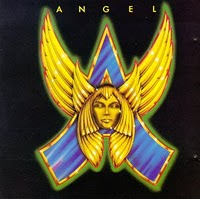 With their matching white outfits, immaculately coiffed locks, and over the top stage presence, Angel were a band ready to take the technicolor seventies by storm, and their ’75 debut easily ranks high among the greats of the decade’s American pomp ‘n’ rollers. With the heavenly helium-fueled vocals of Frank DiMino, crunchy axework of poutin’ Punky Meadows, and Greg Giuffra’s laser-blasting synths, there’s nothing shy or restrained about the Angel sound. Angel leads off with a pair of 7 minute epics in the fantasy chronicle “The Tower” and plaintive “Long Time,” before kicking into the stage-stormin’ “Rock and Rollers.” The heavy groove of “Broken Dreams,” dramatic ballad “Mariner,” king sized riffs of “Sunday Morning” and heroic “On and On” keep side two moving, and the band bids farewell with the brief instrumental, “Angel (Theme).” Not unlike Styx, a band who took the same formula to greater success, Angel deftly walk the tightrope bridging grandiosity and heaviosity throughout this stellar set. –Ben
With their matching white outfits, immaculately coiffed locks, and over the top stage presence, Angel were a band ready to take the technicolor seventies by storm, and their ’75 debut easily ranks high among the greats of the decade’s American pomp ‘n’ rollers. With the heavenly helium-fueled vocals of Frank DiMino, crunchy axework of poutin’ Punky Meadows, and Greg Giuffra’s laser-blasting synths, there’s nothing shy or restrained about the Angel sound. Angel leads off with a pair of 7 minute epics in the fantasy chronicle “The Tower” and plaintive “Long Time,” before kicking into the stage-stormin’ “Rock and Rollers.” The heavy groove of “Broken Dreams,” dramatic ballad “Mariner,” king sized riffs of “Sunday Morning” and heroic “On and On” keep side two moving, and the band bids farewell with the brief instrumental, “Angel (Theme).” Not unlike Styx, a band who took the same formula to greater success, Angel deftly walk the tightrope bridging grandiosity and heaviosity throughout this stellar set. –Ben
Santana “Welcome” (1973)
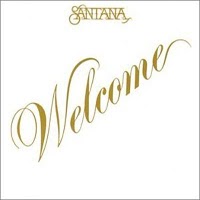 Welcome stands between two popular Santana LPs, Caravanserei and Borboletta, and it’s perhaps the most underrated Santana album. Like the previous LP, Welcome has a recording sound which can easily match today’s standards. This band had it all. The album opens with an instrumental meditation dominated by Alice Coltrane’s organ sound. The first highlight is Samba de Sausalito with a marvelous undercurrent of percussion and a good e-piano solo by Tom Coster. The next song, When I Look Into Your Eyes is a light Pop tune greatly upvalued by Joe Farrell’s lovely flute solo and the band’s accompaniment and the adventurous production: Leon Thomas uses his yodel as a sound effect and Richard Kermode comes in with a super-funky keyboard riff on which the song fades out. Next is one of my all-time Santana favorites, Yours Is The Light featuring Flora Purim, a Brazilian rhythm, Leon Thomas’ whistling and a very disciplined yet inspired solo by Carlos himself. Side Two starts with another great instrumental, Mother Africa recalling Earth, Wind & Fire’s Head To The Sky from the same year, Coltrane (Jules Brussard’s soprano solo) and McCoy Tyner. Light Of Life evokes the atmosphere of Gato Barbieri’s soundtrack, Last Tango In Paris. And now, the most ambitious instrumental piece on the set, Flame-Sky introducing John McLaughlin. In the face of this guitar giant, however, Carlos does not shy away, he opens with a typical yet inspired solo; the band shows they hold up to any challenge and finally, the Mahavishnu does what he does so well until they duet. The title song closes the circle of this marvelous LP in a quiet way with a meditation. A fantastic LP from beginning to end. The sound engineer can’t be praised too high. Welcome sounds as good today as it sounded back then, a musical adventure and one of the best Rock albums of the 70s. –Yofriend
Welcome stands between two popular Santana LPs, Caravanserei and Borboletta, and it’s perhaps the most underrated Santana album. Like the previous LP, Welcome has a recording sound which can easily match today’s standards. This band had it all. The album opens with an instrumental meditation dominated by Alice Coltrane’s organ sound. The first highlight is Samba de Sausalito with a marvelous undercurrent of percussion and a good e-piano solo by Tom Coster. The next song, When I Look Into Your Eyes is a light Pop tune greatly upvalued by Joe Farrell’s lovely flute solo and the band’s accompaniment and the adventurous production: Leon Thomas uses his yodel as a sound effect and Richard Kermode comes in with a super-funky keyboard riff on which the song fades out. Next is one of my all-time Santana favorites, Yours Is The Light featuring Flora Purim, a Brazilian rhythm, Leon Thomas’ whistling and a very disciplined yet inspired solo by Carlos himself. Side Two starts with another great instrumental, Mother Africa recalling Earth, Wind & Fire’s Head To The Sky from the same year, Coltrane (Jules Brussard’s soprano solo) and McCoy Tyner. Light Of Life evokes the atmosphere of Gato Barbieri’s soundtrack, Last Tango In Paris. And now, the most ambitious instrumental piece on the set, Flame-Sky introducing John McLaughlin. In the face of this guitar giant, however, Carlos does not shy away, he opens with a typical yet inspired solo; the band shows they hold up to any challenge and finally, the Mahavishnu does what he does so well until they duet. The title song closes the circle of this marvelous LP in a quiet way with a meditation. A fantastic LP from beginning to end. The sound engineer can’t be praised too high. Welcome sounds as good today as it sounded back then, a musical adventure and one of the best Rock albums of the 70s. –Yofriend
Ry Cooder “Chicken Skin Music” (1976)
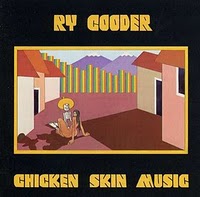 This largely acoustic set composed entirely of covers is an interesting offering from Mr Cooder and various buddies. It looks like he wanted to collaborate with musicians specializing in traditional styles of popular music. The fact that he chooses to record two songs by Leadbelly, himself one of America’s great folk musicians, reinforces this notion. The hybrid “Always Lift Him Up/Kanaka Wai Wai” brings together a wonderfully positive gospel-sounding song from West Virginia and guitar music from Hawaii. “He’ll Have to Go” features some lovely “Tex-Mex” style accordion playing that almost gives the song a french flavor. There is some sensuous Polynesian music in “Yellow Roses” and “Chloe”. It’s a clever album by someone who obviously has a deep love for and great knowledge of popular music. The singing sometimes lets the quality down a little, but the musicianship, arrangements and production are almost faultless. For sheer listening pleasure this one is hard to beat. –Jim
This largely acoustic set composed entirely of covers is an interesting offering from Mr Cooder and various buddies. It looks like he wanted to collaborate with musicians specializing in traditional styles of popular music. The fact that he chooses to record two songs by Leadbelly, himself one of America’s great folk musicians, reinforces this notion. The hybrid “Always Lift Him Up/Kanaka Wai Wai” brings together a wonderfully positive gospel-sounding song from West Virginia and guitar music from Hawaii. “He’ll Have to Go” features some lovely “Tex-Mex” style accordion playing that almost gives the song a french flavor. There is some sensuous Polynesian music in “Yellow Roses” and “Chloe”. It’s a clever album by someone who obviously has a deep love for and great knowledge of popular music. The singing sometimes lets the quality down a little, but the musicianship, arrangements and production are almost faultless. For sheer listening pleasure this one is hard to beat. –Jim
Robin Trower “Bridge of Sighs” (1974)
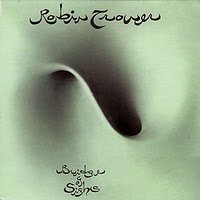 Post-Hendrix bluesy power trios have a tendency to put competency over inspiration, attempting to match Hendrix’s technique without considering his tunefulness or his essential emphasis on feel. It doesn’t take a lot of imagination or style to put out a solid blues-rock album so long as you learn your instrument and learn it well. But once in a while this form finds some unique angle to exploit. Bridge of Sighs is a case in point. Former Procol Harum guitar whiz Trower uses a bank of effects pedals to produce a swirling, oceanic sound with sustain that hangs in the air for hours: lithe and surprisingly light of touch for the music’s intensity, his style on this album should have guitarheads frothing at the mouth. Singer/bassist James Dewar is no slouch, either, sounding rather like Paul Rodgers in a lower register, and anchoring Trower’s waves of sound firmly in the blues. The title track is a wonderful, atmospheric dirge-like thing, and closer “Little Bit of Sympathy” is another standout. It’s a stylish and well produced album, Trower is a pretty amazing guitar player with a strong sense of melody and an uncanny ability to do a lot with few notes, and those whose appetite for good guitar albums is never sated should definitely pick this up. –Will
Post-Hendrix bluesy power trios have a tendency to put competency over inspiration, attempting to match Hendrix’s technique without considering his tunefulness or his essential emphasis on feel. It doesn’t take a lot of imagination or style to put out a solid blues-rock album so long as you learn your instrument and learn it well. But once in a while this form finds some unique angle to exploit. Bridge of Sighs is a case in point. Former Procol Harum guitar whiz Trower uses a bank of effects pedals to produce a swirling, oceanic sound with sustain that hangs in the air for hours: lithe and surprisingly light of touch for the music’s intensity, his style on this album should have guitarheads frothing at the mouth. Singer/bassist James Dewar is no slouch, either, sounding rather like Paul Rodgers in a lower register, and anchoring Trower’s waves of sound firmly in the blues. The title track is a wonderful, atmospheric dirge-like thing, and closer “Little Bit of Sympathy” is another standout. It’s a stylish and well produced album, Trower is a pretty amazing guitar player with a strong sense of melody and an uncanny ability to do a lot with few notes, and those whose appetite for good guitar albums is never sated should definitely pick this up. –Will
James Gang “Rides Again” (1970)
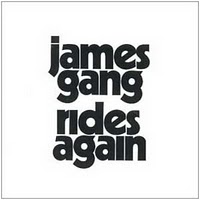 Rides Again is an interesting album. It comes at the dawn of hard rock following on the heels of the psychedelic blues rock revolution. The album itself is half hard rock, where the influence of Zeppelin can be heard, and half something else, more akin to CSN or Neil Young. The album opens in fine form with the classic blues hook, “Funk #49.” “Woman” is another great hard-rocker, followed by the experimental suite “The Bomber” containing a neat interpretation of Ravel’s “Bolero.” The second side starts off quietly. “Tend my Garden” has some of the harmonies associated with CSN. This song fades into “Garden Gate,” an acoustic piece which finds Joe Walsh asking questions. “There I Go Again” is an annoyingly catchy song which features some great pedal steel guitar from guest Rusty Young. “Ashes the Rain and I” closes the album in thoughtful, almost sad, fashion. Dale Peters plays six string on this one and orchestration is added by Jack Nitzsche. It seemed to be de rigueur for US artists of the time to have Nitzsche orchestrate something for them…still it’s tastefully done. The material on this album is very varied, surprisingly hard and, at times, surprisingly progressive. –Jim
Rides Again is an interesting album. It comes at the dawn of hard rock following on the heels of the psychedelic blues rock revolution. The album itself is half hard rock, where the influence of Zeppelin can be heard, and half something else, more akin to CSN or Neil Young. The album opens in fine form with the classic blues hook, “Funk #49.” “Woman” is another great hard-rocker, followed by the experimental suite “The Bomber” containing a neat interpretation of Ravel’s “Bolero.” The second side starts off quietly. “Tend my Garden” has some of the harmonies associated with CSN. This song fades into “Garden Gate,” an acoustic piece which finds Joe Walsh asking questions. “There I Go Again” is an annoyingly catchy song which features some great pedal steel guitar from guest Rusty Young. “Ashes the Rain and I” closes the album in thoughtful, almost sad, fashion. Dale Peters plays six string on this one and orchestration is added by Jack Nitzsche. It seemed to be de rigueur for US artists of the time to have Nitzsche orchestrate something for them…still it’s tastefully done. The material on this album is very varied, surprisingly hard and, at times, surprisingly progressive. –Jim


